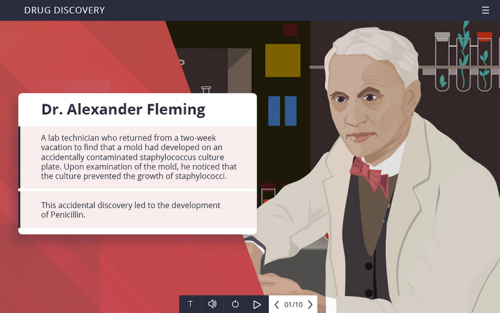With more employers (and workers) opting for remote work, delivering highly engaging and meaningful employee training across the organization is a challenge. Why? Because remote learners face a slew of “distractions” that in-class learners don’t! The best way to improve learner participation among distance learners is to create highly engaging interactive eLearning content.
What is interactive eLearning?
“Old school” teaching aids, such as PowerPoint Slides, scrolling text or audio files delivered one-way, passive learning, and learners often “turned off” after repeatedly pressing the “Next” button.
Adding interactivity to learning content compels the learner to provide responses, feedback, or reaction to the content. And that’s the hallmark of interactive online learning: Learners receive content. They (are encouraged to!) respond to what they learn. The content builds upon those responses to then review, re-phrase or reinforce teaching points…and the cycle continues.
This interaction breeds learner engagement and participation.
Examples of Interactive eLearning
The best way to get learner engagement with interactive learning content is to match learning objectives with specific types of interactive learning elements. Sometimes, a single element might not suffice – you may need to mix and match from multiple types of eLearning interactivity. Here are some proven interactive eLearning examples worth considering.
Simulations & Scenarios
If you want your learners to engage in learning, in as close an environment as you can get to real life, then the use of simulations and scenario-based learning is the right tool. This approach puts learners in simulated real-world situations, but with two added advantages: It’s more cost-effective, and entails less risk (e.g., simulating a fire drill without starting a fire!).
Best Practices:
- Rather than using routine situational scenarios, simulate your scenarios to elicit critical thinking, where employees must make critical decisions, choose from multiple responses, and influence specific outcomes
- Where possible, base your scenarios on real-life challenges rather than unlikely, hypothetical situations. These may be related to performing specific roles, accomplishing certain goals, or resolving unique problems through time-based activities
- Ideally, use actual experiences – e.g., a failed product launch 2-years ago – to simulate your use cases. This approach lends itself to better delivery of real-world lessons learned
Use Case
The airline industry is renowned for its use of simulation in interactive eLearning programs. While well-known for simulating scenarios, such as flying in challenging weather, or piloting through equipment failure, other scenarios include dealing with rowdy passengers or handling onboard medical emergencies.

Story-based eLearning
In an MIT feature article, titled “The four elements of every successful story”, executive coach, inspirational speaker, and leadership guru, Robert Dickman, had this to say about the definition of a story:
“A story is a fact wrapped in an emotion that can compel us to take action and so transform the world around us.”
– Robert Dickman, THE FOUR ELEMENTS OF EVERY SUCCESSFUL STORY
These characteristics of stories make them ideal tools for interactive online learning. The ultimate objective of corporate learning and training is to effect thought and behavioral change in the workplace.

L&D professionals can integrate stories into various eLearning formats, to deliver learning objectives, including eBooks, Character-based dialogues, Narrative format (recounting events and facts), or Scenario-based instructions.
Best Practices:
Regardless of which form you choose for your story-based interactive eLearning model, the best way to deliver your learning objectives is to follow Dickman’s PHAT moniker:
- Passion: Build your story and dialogues around a passionate theme that resonates with your learner
- Hero: Use characters whom learners can relate to. They are the ones that’ll most inspire learners into engagement, action, and behavioral change
- Antagonist: Make sure the story addresses specific obstacles in the workplace or deals with real-world problems (albeit presented in fictional settings). With no element of antagonism, stories will fail to inspire passion among your learners
- Transformation: The story must result in the desired transformation – it must be a natural conclusion: Hero’s get passionate about a problem, and take action to transform the world around them
Use Case
Because stories make such powerful teaching aids, higher institutions of learning, such as Georgetown University’s School of Continuing Studies, offer a formal online program for teaching the art and science of Social Impact Storytelling. The program has successfully used interactive eLearning examples of stories to teach changemakers from across the spectrum – marketers, communicators, fundraisers, and journalists – the value of corporate storytelling as an effective medium of change.
Gamified eLearning
Gamification is the technique of incorporating gaming elements in eLearning. It’s human nature, that we love doing things we enjoy. And it’s that very characteristic of gaming that lends itself to highly engaging, immersive, and accessible interactive eLearning courses. Instructional designers have plenty of gaming models to choose from. Some common games include:
- Digitally-simulated board games
- Audio-visual crossword puzzles
- Slot machines, Spin-the-Wheel
- Drag/drop matching games

Best Practices:
Consider these best practices for game-based eLearning:
- Choose game-based learning to fit with the type of eLearning being delivered. A simple course might work best with partial gamification, while higher-level courses might require fully gamified learning paths and gaming portals
- L&D professionals can either incorporate games as stand-alone features or as an integrated set of multi-level gaming lessons involving several elements (Dice games, Crosswords, etc.)
- The most engaging games come with visually-appealing design features, combined with high levels of in-game navigation elements (pause, help, hints, back, skip, etc.)
- While some interactive eLearning examples, such as Crosswords, and Drag/drop gaming, might work well with individual learners, multi-player games are great for group and social learning
- Make sure you include aspects such as challenges, competitions, leaderboards, and badges
Use Case
There’s no better use case for game-based interactive eLearning than Hilton Garden Inns’ very own Ultimate Team Play. Designed in a 3D setting, for Sony’s PSP® (PlayStation®Portable), the game places team members in an actual simulation of a Hilton hotel, and trains learners through various aspects of their roles and responsibilities.
Assessments and Quizzes
These aspects of learning are likely the most common of all elements found in most online courses. While both, Assessments and Quizzes, work well as learning tools, the former is more useful as an evaluation method, while the latter works well as a tool for review, revision, and reinforcement. Points and badges offer additional incentives to participate in assessments and quizzes.

Best Practices:
It’s common practice for instructional designers to include questions and answers as part of interactive online learning quizzes and assessments. However, here are some best practices to consider for these aspects of any virtual learning program:
- Include a mix of question types, including sentence responses, one-word answers, and even audio questions
- It’s important to include some timed-based questions in the question bank
- When assessing responses, in addition to providing additional supplemental information about correct responses, make sure to offer expanded feedback on why an answer is incorrect
- Points, scores, and rewards (virtual badges, digital trophies, etc.) add to the motivation and engagement aspect of game-based quizzes and assessments
Use Case
Companies can use Assessments and Quizzes in various formats, as part of their virtual learning programs. Develop a series of Question Pools to “dip into” when evaluating compliance readiness. And, a set of quizzes from a Question Bank, related to a company’s hiring and promotions policy, may be appropriate for an HR course.
Adapting to Evolving Learner Engagement
Techniques to foster learner engagement are continually evolving. For instance, other interactive eLearning examples include the use of embedded videos in presentation slides and “talking” PDF documents. However, for the most part, those newer techniques can easily be integrated into the four main techniques discussed earlier.






